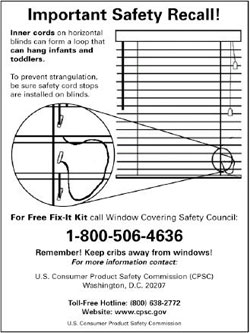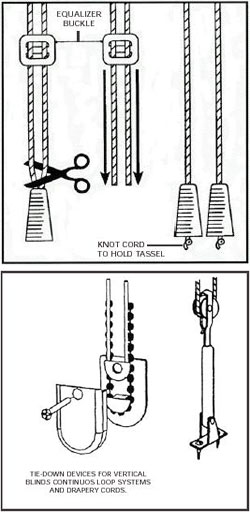Share
Related Topics
Tagged As
In cooperation with the U.S. Consumer Product Safety Commission (CPSC), the Window Covering Safety Council (WCSC) announced recalls to repair horizontal window blinds to prevent the risk of strangulation to young children. The recalls involved millions of window blinds with pull cords and inner cords that can form a loop and cause strangulation.
We do not strictly control Google ad content. If you believe any Google ad is inappropriate, please email us directly here.
From 1991 to 2000, CPSC received reports of 160 strangulations involving cords on window blinds: 140 strangulations involved the outer pull cords, and 20 involved the inner cords that run through the blind slats.
In 1994, CPSC worked with the window covering industry to redesign new window blinds to eliminate the outer loop on the end of the pull cords and provide free repair kits so consumers could fix their existing blinds. Window blinds sold since 1995 no longer have pull cords ending in loops.
In 1999, CPSC began a new investigation of window blind deaths. In an extensive review of incidents, CPSC found that children could also become entangled in the inner cords that are used to raise the slats of blinds. These entrapments occur when a young child pulls on an inner cord and it forms a loop that a child can hang in. All of these deaths involved children in cribs or playpens placed next to windows. In most cases, the outer pull cords were placed out of reach, but the children still strangled when they pulled on the inner cords of the blinds. The strangulation victims ranged in age from 9 months to 17 months.
These entrapments occur when a young child pulls on an inner cord and it forms a loop that a child can hang in. All of these deaths involved children in cribs or playpens placed next to windows. In most cases, the outer pull cords were placed out of reach, but the children still strangled when they pulled on the inner cords of the blinds. The strangulation victims ranged in age from 9 months to 17 months.
As a result of the CPSC investigation, the industry has further redesigned window blinds. Window blinds sold since November 2000 have attachments on the pull cords so that the inner cords can’t form a loop if pulled by a young child. Consumers with blinds bought before Nov. 2000 should repair them.
Consumers who have window blinds with loops should immediately visit WCSC (windowcoverings.org/cgi-bin/forms/forms.cgi?form=4) or call (800) 506-4636 to receive a free repair kit for each set of blinds. The repair kit includes small plastic attachments to prevent inner cords from being pulled loose. Instructions for cord stop installation (http://www.windowcoverings.org/how-to-retrofit/) are easy and repair can be done in minutes without removing blinds.
 The kit also includes safety tassels for pre-1995 window blinds with outer pull cords ending in loops. Consumers should cut the loops and install the safety tassel at the end of each pull cord (left illustration).
The kit also includes safety tassels for pre-1995 window blinds with outer pull cords ending in loops. Consumers should cut the loops and install the safety tassel at the end of each pull cord (left illustration).
Consumers who have vertical blinds, draperies or pleated shades with continuous loop cords can also order from the same toll-free number a special tiedown to prevent strangulation in those window coverings (right illustration)
Parents should keep window covering cords and chains permanently out of the reach of children. Never place a child’s crib or playpen within reach of a window blind. Unless the cords can be completely removed from the child’s reach, including when the child climbs on furniture, CPSC recommends against knotting or tying the cords together because this creates a new loop in which a child could become entangled.
HHI Error Correction Policy
HHI is committed to accuracy of content and correcting information that is incomplete or inaccurate. With our broad scope of coverage of healthful indoor environments, and desire to rapidly publish info to benefit the community, mistakes are inevitable. HHI has established an error correction policy to welcome corrections or enhancements to our information. Please help us improve the quality of our content by contacting allen@healthyhouseinstitute.com with corrections or suggestions for improvement. Each contact will receive a respectful reply.
The Healthy House Institute (HHI), a for-profit educational LLC, provides the information on HealthyHouseInstitute.com as a free service to the public. The intent is to disseminate accurate, verified and science-based information on creating healthy home environments.
While an effort is made to ensure the quality of the content and credibility of sources listed on this site, HHI provides no warranty - expressed or implied - and assumes no legal liability for the accuracy, completeness, or usefulness of any information, product or process disclosed on or in conjunction with the site. The views and opinions of the authors or originators expressed herein do not necessarily state or reflect those of HHI: its principals, executives, Board members, advisors or affiliates.








